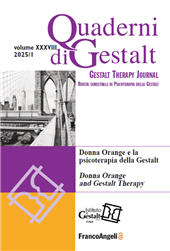La terapia della Gestalt come atto estetico : dalla sensazione alla formazione delle forme
71-83 p.
La psicoterapia della Gestalt, come atto estetico, si concentra sull'evoluzione della sensazione in forme concrete. Oggi, l'estetica filosofica gioca un ruolo cruciale nella teoria della psicoterapia della Gestalt, contribuendo alla elaborazione di una psicopatologia e alla comprensione della relazione terapeutica. L'estetica di Baumgarten si basa sull'aesthesis, sulla sensazione e conoscenza sensibile, evidenziando che il contatto con l'altro avviene attraverso le percezioni e le sensazioni. L'atto estetico va oltre la semplice sensazione: si tratta di una metamorfosi, un cambiamento di forma. In psicoterapia, molti pazienti sentono ma non riescono a trasformare queste sensazioni in azioni. Il compito del terapeuta è facilitare questa trasformazione, permettendo al paziente di appropriarsi delle proprie sensazioni e di vivere l'estetica della metamorfosi. [Testo dell'editore]
Today, reference to philosophical aesthetics seems to be taking on an increasingly important role in the theoretical apparatus of gestalt-therapy, including as a contribution to the development of a specific psychopathology or theorization of the therapeutic encounter. Baumgarten's original aesthetics were primarily concerned with what I would prefer to call aesthesis, since it is essentially a matter of feeling, of sensitive knowledge. When we speak of anesthesia, kinesthesia, paresthesia, etc., the various prefixes nuance the forms of aesthesis, of feeling. Baumgarten thus invited us to embark on a veritable epistemology of sensibility: I can access the other only through my senses, i.e., my perceptions and sensations in their presence, perceptions and sensations that are then transformed into feelings, thoughts, representations, imaginations, inferences, projections, knowledge The evolution of the concept has clearly shown that the aesthetic act does not stop at feeling, or even
feeling what I feel, because this feeling (aesthesis) is transformed into an act. The aesthetic act extends into a change of form, i.e., meta-morphosis, trans-formation. If, among Gestalt Therapists, aesthetic reference is sometimes dominated by or even limited to what I've called aesthesis (aesthesis stage?), there's a risk of forgetting that even this phase of the process, this implicit, mainly sensory-motor knowledge, doesn't make us mere receivers. We are actors, that is, producers of acts, the first of which is to "feel what I feel". In the therapeutic situation, every therapist has often been confronted with the fact that some patients "feel" but don't know how to carry out the work that enables this feeling to be transformed. The process of feeling is immobilized and fixed in various pathological forms; the metamorphosis of feeling into action itself requires an act, an intervention. The psychotherapist's task, his act, enables the patient to appropriate his feeling, to feel
that he feels, and to experience the metamorphosis of this feeling, the forming of forms, an aesthetic act. [Publisher's text]
-
Artikel aus derselben Ausgabe (einzeln erhältlich)
-
Informationen
ISSN: 2035-6994
KEYWORDS
- Estetica, sentimento, sensazione, formazione delle forme
- Aesthetics, feeling, sensation, formation of forms


